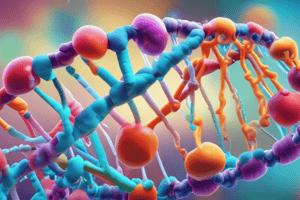Podcast
Questions and Answers
What are the two main types of nucleic acids?
What are the two main types of nucleic acids?
- Cytosine and Phosphate
- DNA and RNA (correct)
- Deoxyribose and Thymine
- Adenine and Guanine
Which nitrogenous base pairs with cytosine in DNA?
Which nitrogenous base pairs with cytosine in DNA?
- Adenine
- Thymine (correct)
- Phosphate
- Guanine
What is the role of rRNA in gene expression?
What is the role of rRNA in gene expression?
- Blueprint for protein synthesis by ribosomes
- Serves as a template for protein synthesis
- Structural component of ribosomes (correct)
- Transports mRNA out of the nucleus
Which molecule consists of nitrogenous bases, deoxyribose sugar, and phosphate groups?
Which molecule consists of nitrogenous bases, deoxyribose sugar, and phosphate groups?
What is the function of tRNA in gene expression?
What is the function of tRNA in gene expression?
How are the two strands of DNA held together?
How are the two strands of DNA held together?
What is the role of tRNA in protein synthesis?
What is the role of tRNA in protein synthesis?
How does the genetic code dictate the sequence of amino acids in proteins?
How does the genetic code dictate the sequence of amino acids in proteins?
Which statement accurately describes the applications of nucleic acids in biomedical research?
Which statement accurately describes the applications of nucleic acids in biomedical research?
What does a unique anticodon on tRNA correspond to?
What does a unique anticodon on tRNA correspond to?
Why is the understanding of nucleic acids fundamental to our understanding of life?
Why is the understanding of nucleic acids fundamental to our understanding of life?
In what way can nucleic acid analogues be beneficial in biomedical applications?
In what way can nucleic acid analogues be beneficial in biomedical applications?
Study Notes
Nucleic Acids: The Building Blocks of Life
Introduction
Nucleic acids are the molecular structures that carry genetic information in living organisms. They consist of two main types: deoxyribonucleic acid (DNA) and ribonucleic acid (RNA). DNA is the hereditary material found in all living organisms, while RNA is an essential component of the gene expression process.
DNA: The Genetic Material
DNA is a double-stranded molecule composed of nucleotides, which are the building blocks of DNA. Each nucleotide consists of a nitrogenous base (adenine, guanine, cytosine, or thymine), a five-carbon sugar (deoxyribose), and one or more phosphate groups. The two strands of DNA are held together by hydrogen bonds between complementary base pairs: adenine pairs with thymine, and guanine pairs with cytosine.
RNA: The Intermediate Messenger
RNA is a single-stranded molecule that plays a crucial role in the process of gene expression. There are three main types of RNA: messenger RNA (mRNA), ribosomal RNA (rRNA), and transfer RNA (tRNA). Each type of RNA has a specific function in gene expression.
- mRNA: It serves as a template for protein synthesis. After a gene is transcribed into mRNA, the mRNA is transported out of the nucleus into the cytoplasm, where it serves as a blueprint for protein synthesis by ribosomes.
- rRNA: It is a structural component of ribosomes, the molecular machines responsible for protein synthesis. Ribosomes consist of two rRNA molecules and several proteins.
- tRNA: It is a small, cloverleaf-shaped molecule that brings amino acids to the ribosome during protein synthesis. Each tRNA molecule is specific for a particular amino acid and has a unique anticodon that pairs with the codon on the mRNA.
Nucleic Acids and Protein Synthesis
The genetic code is the set of rules that dictate how the sequence of nucleotides in DNA and RNA determines the sequence of amino acids in proteins. This code is a triplet code, where each codon (a sequence of three nucleotides) corresponds to a particular amino acid. This code ensures that the genetic information stored in DNA can be translated into the proteins that are essential for life.
Nucleic Acids and Their Analogues for Biomedical Applications
Nucleic acids have various applications in biomedical research and therapy. They can be used as gene regulation tools, sensing platforms for detecting ions, small molecules, proteins, and cells, and as building blocks for self-assembly of highly ordered nanostructures. Chemically modified nucleic acid analogues can also be generated to enhance their biological properties.
In conclusion, nucleic acids are the essential macromolecules that carry genetic information in living organisms. They play a crucial role in gene expression and protein synthesis, and their understanding is fundamental to our understanding of life itself.
Studying That Suits You
Use AI to generate personalized quizzes and flashcards to suit your learning preferences.
Description
Test your knowledge on the structure and function of nucleic acids, including DNA and RNA, as well as their roles in gene expression and protein synthesis. Explore the genetic code, types of RNA, and biomedical applications of nucleic acids.



